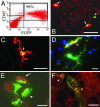Human CD34+ cells differentiate into microglia and express recombinant therapeutic protein
- PMID: 14990803
- PMCID: PMC373501
- DOI: 10.1073/pnas.0306431101
Human CD34+ cells differentiate into microglia and express recombinant therapeutic protein
Abstract
In rodents, bone marrow-derived cells enter the brain during adult life. Allogeneic bone marrow transplantation is used to treat genetic CNS diseases, but the fate of human bone marrow and CD34(+) cells within the brain remains to be elucidated. The present study demonstrates that cells derived from human CD34(+) cells, isolated from either cord blood or peripheral blood, migrate into the brain after infusion into nonobese diabetic/severe combined immunodeficient mice. Both types of CD34(+)-derived cells differentiate into perivascular and ramified microglia. The lentiviral transfer of genes into CD34(+) cells before infusion does not modify the differentiation of human CD34(+) cells into microglia, allowing new transgenic proteins to be expressed in these cells. The transplantation of CD34(+) cells could thus be used for the treatment of CNS diseases.
Figures





References
-
- Lawson, L. J., Perry, V. H., Dri, P. & Gordon, S. (1990) Neuroscience 39, 151-170. - PubMed
-
- Perry, V. H. & Gordon, S. (1991) Int. Rev. Cytol. 125, 203-244. - PubMed
-
- Brazelton, T. R., Rossi, F. M., Keshet, G. I. & Blau, H. M. (2000) Science 290, 1775-1779. - PubMed
-
- Mezey, E., Chandross, K. J., Harta, G., Maki, R. A. & McKercher, S. R. (2000) Science 290, 1779-1782. - PubMed
Publication types
MeSH terms
Substances
LinkOut - more resources
Full Text Sources
Other Literature Sources
Medical

